Why Dryland Workouts for Swimmers Should Be Part of Every Swim School Program
Pratheeksha Mani
October 30, 2025
‧
10 min read
Imagine teaching a child to swim, but only focusing on techniques. It’s like trying to build a house without laying the foundation, the structure simply won’t hold up. No matter how technically sound a swimmer’s stroke is, if they lack the strength, flexibility, or stamina to support it, they will struggle to perform at their best. That’s why dryland workouts for swimmers are a vital part of training at all levels, from beginners to advanced.
As a swim school owner, adding a structured dryland program can set your academy apart. It creates stronger, safer swimmers, builds endurance, reduces injury risks, and improves water confidence. Yet many swim schools overlook this piece of the puzzle.
In this blog, we will explore what dryland workouts for swimmers are, why they are crucial, and how to build a program that works for your school. Let’s get started!
Dryland workouts refer to exercises done outside the pool to support and enhance swimming performance in the water. It includes strength training, balance exercises, flexibility routines, core strengthening, and movement drills that complement swimming motions. It’s about preparing the body to handle the demands of swimming—stronger muscles, flexible joints, better balance, and safer movement patterns.
Unlike swimming laps or refining strokes during lessons, dryland exercises for swimmers focus on building overall athletic ability: a tight core (planks, bird dogs, Russian twists), lower body strength (lunges, squats), upper body power (push-ups, pull-ups) and full-body activation (jumping jacks, burpees, mountain climbers). An effective dryland regime includes a range of such exercises to boost strength, stamina and a solid foundation for swimming.
Imagine teaching a child how to swim freestyle, but they don’t have enough core strength to hold a straight body position. They might know the technique, but their legs sink, their hips twist, and their stroke falls apart halfway down the lane.
Now imagine that same swimmer has been practicing dryland planks, and balance drills. They have developed stronger core muscles and better control of their body. When they return to the pool, their streamline improves automatically, they stay flatter, faster, and more efficient.
That’s the power of dryland: it turns good technique into great performance by giving the body the tools to support it.
Some of the key elements of dryland workouts include:
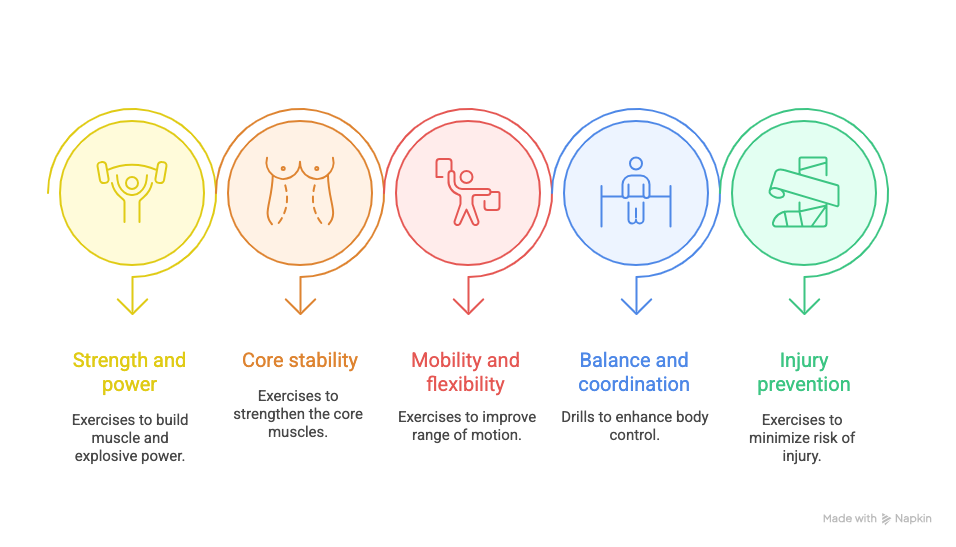
For stronger strokes, explosive starts, and faster turns.
Example: Squat jumps help build the leg power needed for quick push-offs from the wall.
To maintain body alignment and a streamlined position in the water.
Example: Plank holds train swimmers to keep their bodies tight and controlled during freestyle, backstroke, and underwater dolphin kicks.
For smooth, injury-free movement, especially in the shoulders and hips.
Example: Shoulder circles and dynamic stretches help swimmers reach further without straining.
For better control during strokes, breathing, and turns.
Example: Single-leg balance exercises help swimmers develop body awareness, which improves stroke timing and breathing rhythm.
To strengthen small stabilizing muscles that often get neglected, reducing the risk of overuse injuries (especially in the shoulders).
Example: Resistance band external rotations protect the rotator cuff and keep shoulders healthy.
As a swim school owner, your focus is on helping students become confident, capable swimmers. Dryland training accelerates this process in several ways:

Swimming isn’t just about technique; it’s about having the strength and stamina to hold good form. A strong core and stable shoulders help swimmers maintain correct positioning and reduce wasted energy.
Swimming is a full-body sport. Dryland workouts build the muscles needed for stronger pulls, kicks, starts, and turns—without the strain of endless laps in the pool.
Swimmers, even at a young age, are prone to overuse injuries, especially in the shoulders. Dryland helps by strengthening supporting muscles, improving joint mobility, and correcting imbalances.
Dryland teaches swimmers how to control their bodies on land, improving coordination and balance. This translates directly to better movement patterns in the water, especially for beginners still learning body position and breathing.
Dryland training builds general fitness, making swimmers feel stronger and more confident. When students feel fit, they can focus more on technique and less on fatigue.
Here are five fundamental dryland exercises for swimmers that are easy to introduce, require minimal equipment, and are highly effective:
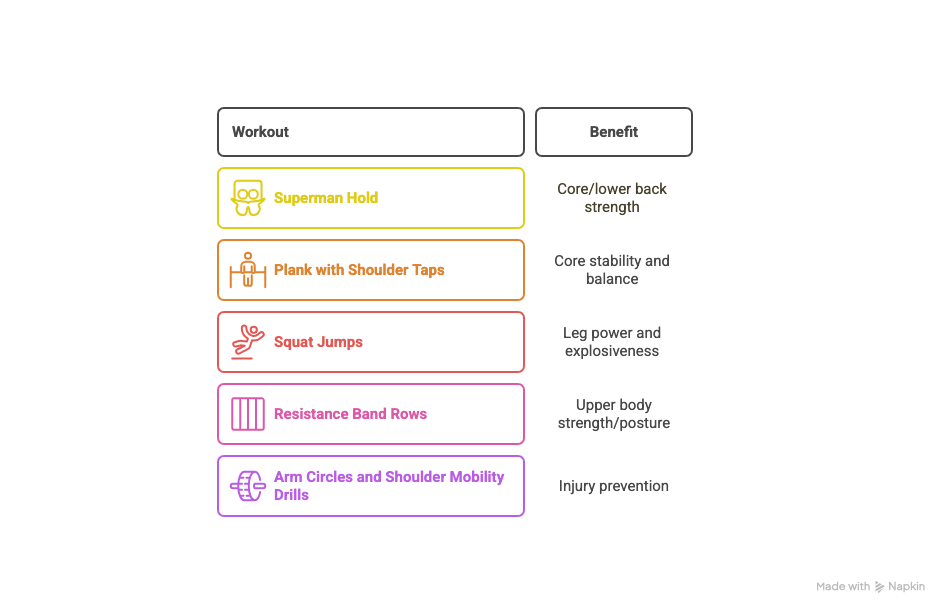
This is a static bodyweight exercise that strengthens the lower back, glutes, and core by holding a “flying” position on the floor.
Why it matters:
A strong back and core help swimmers stay streamlined in the water, reducing drag and improving efficiency during strokes and kicks.
How to do it:
This is a dynamic core exercise where swimmers maintain a plank position while alternately tapping each shoulder. It trains stability and control.
Why it matters:
This movement teaches swimmers to stabilize their core while moving their limbs, which is essential for maintaining body alignment during strokes, breathing, and flip turns.
How to do it:
This is a jumping exercise that builds leg strength and power by combining a squat with a jump. It helps swimmers develop quick, powerful movements needed for starts and turns.
Why it matters:
Strong, explosive legs are crucial for starts, turns, and underwater dolphin kicks—moments where races (or lessons) are often won.
How to do it:
This is a strength exercise using a resistance band to mimic the pulling motion of swimming strokes, especially freestyle and backstroke.
Why it matters:
Strengthens the upper back and shoulders, improves posture, and reinforces the pulling action swimmers use in the water.
How to do it:
This is a combination of dynamic warm-up movements and stretches to improve shoulder flexibility and mobility.
Why it matters:
Swimmers rely heavily on shoulder mobility. These drills keep shoulders loose and healthy, helping to prevent overuse injuries.
How to do it:
- Cross-body arm pulls (hold for 20–30 seconds per side).
- The doorway chest stretches to open up the shoulders and chest.
Starting a dryland workout for swimmers doesn’t require a major change to your schedule. With just a bit of planning, you can gradually introduce dryland exercises as part of your regular lessons. For example, you might add a 10–15 minute dryland warm-up before pool time or run short group sessions on the deck or in a nearby open space. These small additions can make a big difference over time, building strength, flexibility, and coordination without disrupting your existing classes.
Make sure your swim instructors are comfortable teaching basic dryland exercises. Consider bringing in a fitness coach for a one-time workshop or online training session.
For younger swimmers (ages 5–10), focus on body awareness, balance, and playful movements. Use games and animal-themed exercises to keep it engaging. For older students (11+), introduce strength, power, and mobility work gradually.
Begin by adding 10–15 minute dryland sessions before or after swim classes. This helps students build the habit without feeling overwhelmed.
Consistency is key. Dryland is most effective when done regularly—aim for 2–3 sessions per week.
3 sessions per week (e.g., Mon-Wed-Fri)
Each session: 15–20 minutes
Focus: Build awareness, strengthen the core, and practice balance.
Exercises:
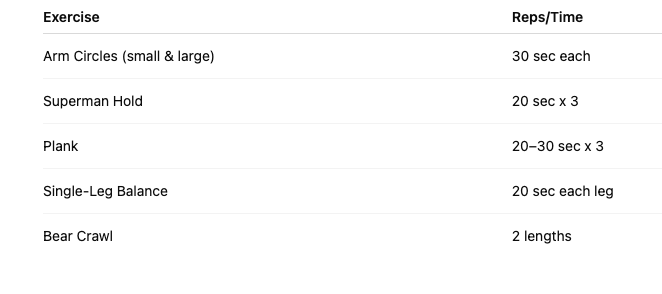
Coach tip:
Keep it playful and focus on control, not speed.
Focus: Build leg power, arm strength, and core control.
Exercises:

Coach tip:
Land jumps softly, use bands or towels for rows, and encourage steady breathing.
Focus: Improve flexibility, stamina, and body control.
Exercises:
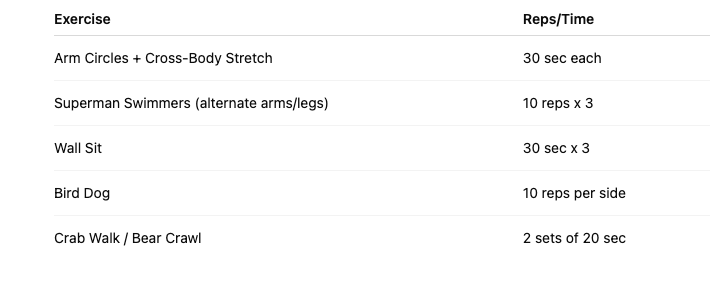
Coach tip:
Keep movements slow and steady. Use games to keep younger kids engaged.
Dryland workouts aren't about replacing swim practice—they are about supporting it. By building strength, flexibility, and coordination outside the pool, your students will swim more efficiently, reduce their risk of injury, and feel more confident in the water.
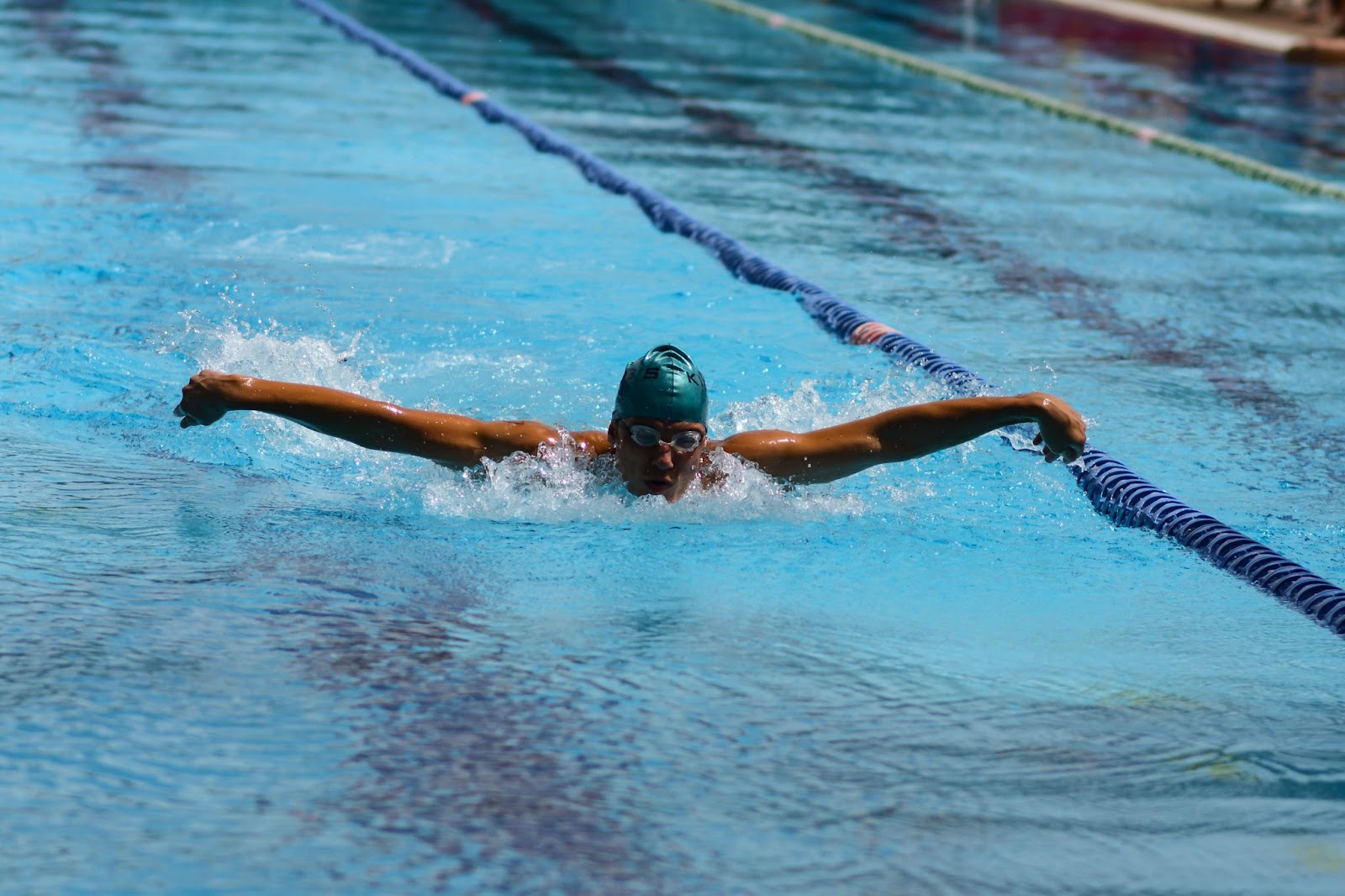
As a swim school owner, adding dryland workouts to your program helps you nurture not just better swimmers, but healthier, more well-rounded athletes. And the good news is—you don’t need to worry about the added logistics. With tools like Classcard, you can easily plan, organize, and schedule sessions seamlessly. Whether you are managing regular swim lessons, adding new dryland programs, or organizing group sessions, you can easily schedule classes, track attendance, assign instructors, and communicate with parents—all in one place. No spreadsheets, no back-and-forth calls, and no manual reminders.
After all, great swimmers don’t just grow in the pool—they grow from the roots up.
1. How often should schools incorporate dryland workouts for swimmers?
For beginners and younger swimmers, 2-3 short sessions per week (15-20 minutes each) are ideal. It’s about consistency, not intensity. These sessions can be added before or after swim practice or run as separate group classes.
2. Do we need special equipment for dryland workouts?
No! Most beginner dryland exercises use bodyweight only like planks, squats, and superman holds. Optional equipment like resistance bands or towels can be introduced for variety and to develop upper body strength.
3. Is the dryland workout suitable for all ages and levels?
Yes! Dryland workouts can be easily adapted for different age groups and abilities. For younger kids, keep the sessions playful and focused on body awareness. For older students or advanced swimmers, increase reps and add progression over time.
4. Do I need certified fitness coaches to run dryland workouts?
Not necessarily. For beginner-level dryland, swim coaches can easily lead sessions after basic training or workshops. Start with simple, safe exercises like bodyweight movements, balance drills, and mobility work. As your program grows, you can consider bringing in a specialist for advanced levels.
5. How do I track progress in dryland workouts?
Progress can be tracked by observing improved technique, longer hold times, smoother and more controlled movements, and overall consistency. You can also set simple goals, like adding extra reps or improving balance, to help students see their growth over time.